

20 Incredible Illustration Portfolio Examples You Should Bookmark. Build your professional portfolio website in minutes.
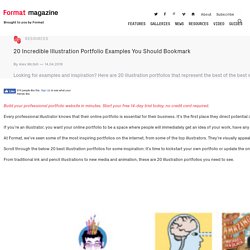
Start your free 14-day trial today, no credit card required. Every professional illustrator knows that their online portfolio is essential for their business. It’s the first place they direct potential clients, the way that they represent their brand, and has the capability to make or break a career. Forget “Style” — Giuseppe Castellano. “Style” is a lazy short-hand.
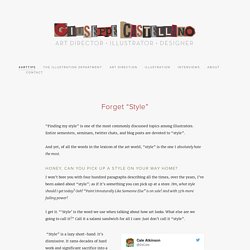
It’s dismissive. It rams decades of hard work and significant sacrifice into a shiny, neat, little package. It’s a convenient way to avoid accepting the fact that you actually have to work—hard—at illustration before it’s deemed publishable by respectable organizations. It’s a distraction—a syphon of energy and time better spent creating, failing, learning, building, evolving, discovering, and developing what you really should be focusing on: finding your voice. Too often, illustrators worry so much about having a “style” that they totally neglect the narrative, the feeling, the message—otherwise known as the voice. Curious Little Toons Discover Household Things. The Proportions of the Head and Face. Proportions of the Head - Illus. 1 Although the proportions of a head will vary from person to person and change slightly with age, there are some basic principles you can follow to improve your drawing.
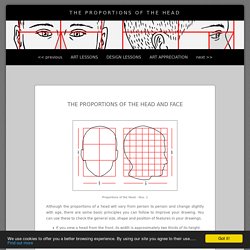
You can use these to check the general size, shape and position of features in your drawings. If you view a head from the front, its width is approximately two thirds of its height. If you view a head from the side, its width is approximately seven eighths of its height. PrintFriendly.com: Print web pages, create PDFs. Your Print Friendly Page is Generating This takes a few seconds.

Any issues, contact support. Art: Sighting with a Viewfinder and Sighting Sticks. Sighting is a jump from Drawing Ia because students are drawing from life and they will convert a 3-D object into a 2-D object on their paper.
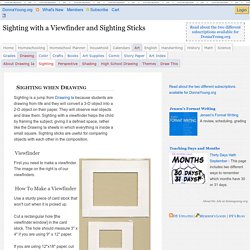
They will observe real objects and draw them. Sighting with a viewfinder helps the child by framing the subject, giving it a defined space, rather like the Drawing Ia sheets in which everything is inside a small square. Drawing Geometric Perspective - dummies. Geometric perspective (sometimes called linear perspective) makes subjects in a drawing look like they recede into distant space, appearing smaller the farther they are away from you.
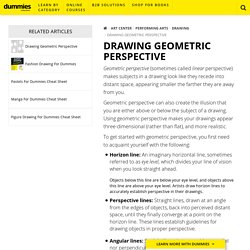
Geometric perspective can also create the illusion that you are either above or below the subject of a drawing. Using geometric perspective makes your drawings appear three-dimensional (rather than flat), and more realistic. To get started with geometric perspective, you first need to acquaint yourself with the following: Horizon line: An imaginary horizontal line, sometimes referred to as eye level, which divides your line of vision when you look straight ahead.
Objects below this line are below your eye level, and objects above this line are above your eye level. Line Drawing: A Guide for Art Students. How to Draw Values & Tones Lessons & Tutorials for Shading & Drawing in Pencil & Pen & Ink in Your Illustrations, Drawings, Cartoons, and Comics. Drawing Relative Tones and Values To study values it is best to commence in the house, as the subject you are about to draw can be made simple.

23 creative sketchbook examples to inspire Art students. This article contains a collection of beautiful sketchbook pages to help students studying a range of high school Art qualifications, including GCSE, A Level and IB Visual Art.
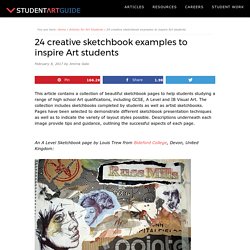
The collection includes sketchbooks completed by students as well as artist sketchbooks. Pages have been selected to demonstrate different sketchbook presentation techniques as well as to indicate the variety of layout styles possible. Descriptions underneath each image provide tips and guidance, outlining the successful aspects of each page. The Sketchbook Challenge: The Spice of Life? VARIETY!
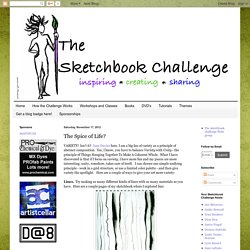
Isn't it? Jane Davies here. I am a big fan of variety as a principle of abstract composition. The smARTteacher Resource: Broken Values. SWAT carefully observe details and draw what they see.
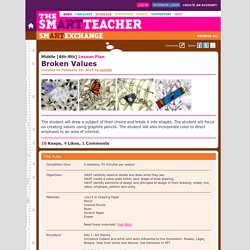
SWAT create a value scale within each shape of their drawing. SWAT identify elements of design and principles of design in their drawing: shape, line, value, emphasis, pattern and unity. Day 1: Art History Introduce Cubism and artist who were influential to the movement. Picasso, Leger, Braque. View their works and discuss. HUMAN PROPORTION: SIMPLIFYING THE FIGURE USING GEOMETRIC FORM ANDGESTURE. Before watching the video tutorial, print out the first two worksheets and read them. Get together with a partner and check if the proportions described on the worksheets are accurate. After watching the video tutorial, try drawing your own geometric figure drawing using accurate proportions.
Most beginners make the head too big, the shoulders too narrow and the arms and legs too short. Take special care to avoid and correct these mistakes. 6 Amazing Art Projects that Incorporate Writing - The Art of Ed. Editor’s Note: This week we’re taking time to talk about a sometimes groan-inducing topic: writing in the art room. The good news is that our team has come up with some fun, engaging ways to incorporate writing into your curriculum that both you and your students will actually enjoy! Mason Jar Shadow Drawing Prompt. After we made a Mason Jar Solar Light, we noticed that our non-frosted mason jar lantern created a loopy, squiggly, and sharp pattern of shadows when illuminated on the table.
To turn this into an art activity, we added a few supplies (a piece of paper and pencil) and played around with this fun and creative shadow drawing prompt. Care to join us? If you don’t already have a solar light mason jar, you’ll need these supplies: Note: This post includes affiliate links Wide Mouth Mason Jars. Click over here for the Mason Jar Solar Light tutorial. If the room isn’t dark enough for the solar panel to activate the light, place a square of dark paper over the panel. 642 Things To Draw Full List – 642 Things To Draw. Cartooning and Animation. Print out this worksheet. Cut out all the strips of paper. Tape them together to form two long strips of paper. Cut out all the gray parts of the paper and save all the white parts. Thread the strips of paper through the slits. Drawing tutorials for human bodies... and also clothing.
Shape Challenge on Design-A-Character - DeviantArt. Everyone Has A Story To Tell. A Monochrome Moleskine. Name Design Art Lessons. Drawing Exercise: Drawing on the Right Side of the Brain. The Vase/Faces Drawing A side benefit of learning to draw is getting to know your own brain a bit better - for example, how, for you, these two modes compete and cooperate. Here is a quick exercise designed to illustrate the mental conflict that can occur between L-mode and R-mode. This is a famous optical illusion drawing, called "Vase/Faces" because it can be seen as either two facing profiles or as a symmetrical vase in the center.
Your job, of course, is to complete the second profile, which will inadvertently complete the symmetrical vase in the center. Illustrating Patterns: Creating Hand-Drawn Wallpaper. 7 Tips on Getting Your First Illustration Project. 7 Tips on Getting Your First Illustration Project. Art: Sighting with a Viewfinder and Sighting Sticks. Each Week, Two Anonymous Students Named Dangerdust Create This Amazing Chalkboard Art. Hyperdetailed Drawings by Kerby Rosanes. 3D Models of the Human Anatomy. Helpful drawing tutorials and references. MUA_Face_Chart_SM.jpg (JPEG Image, 580 × 751 pixels) I collect cute / funny *I love you* Mandala. Engaging Creativity - Sketchbooks. The Bus - Paul Kirchner. The Inkblot Book. Why drawing needs to be a curriculum essential. The Processes and Materials of Abstract Expressionist Painting. Abstract Expressionist explored new ways of creating art, reinvigorating and reinventing the medium.
Mark Making. Tips for Markmaking in Art and Design. Markmaking is a fun and sometimes crazy way to experiment with different mediums and techniques. Put simply, markmaking is just the visible trace left behind by a drawing tool such as a line drawn by a pencil.